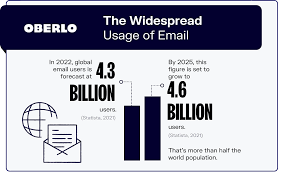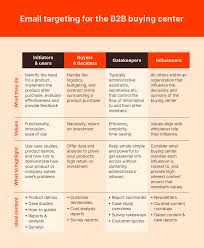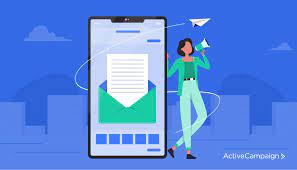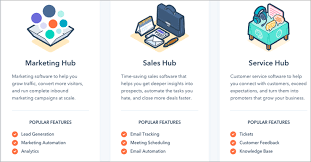Email Marketing Statistics: Unlocking the Power of Email Campaigns
In today’s digital landscape, email marketing remains a powerful tool for businesses to connect with their audience and drive conversions. With its ability to reach a wide range of recipients and deliver targeted messages, email marketing continues to evolve and thrive. Let’s delve into some eye-opening email marketing statistics that highlight its effectiveness and potential.
- Impressive ROI: According to the Direct Marketing Association (DMA), email marketing boasts an average return on investment (ROI) of 4,400%. This staggering figure demonstrates that for every pound or dollar spent on email campaigns, businesses can expect substantial returns. With such a high ROI, it’s no wonder that companies continue to invest in this cost-effective marketing strategy.
- Broad Reach: In 2020, the number of global email users reached a staggering 4 billion. This figure is expected to grow to 4.6 billion by 2025, according to Statista. With such a vast potential audience, businesses have an incredible opportunity to connect with customers worldwide through well-crafted email campaigns.
- Personalization Matters: Personalized emails generate higher engagement rates compared to generic ones. Research shows that personalized subject lines increase open rates by 26%, while personalized content within the email itself boosts click-through rates by an impressive 14%. By tailoring your messages based on recipient preferences and behavior, you can create meaningful connections that drive results.
- Mobile Dominance: With the rise of smartphones and mobile devices, it’s crucial for businesses to optimize their emails for mobile viewing. Approximately 46% of all emails are opened on mobile devices, making responsive design essential for engaging your audience effectively. Neglecting mobile optimization may result in missed opportunities and decreased engagement.
- Automation Delivers Results: Automated emails have become a game-changer in the world of digital marketing. Research indicates that automated welcome emails have an average open rate of 82%. Furthermore, automated email campaigns can nurture leads, re-engage customers, and improve customer retention. By leveraging automation tools, businesses can streamline their email marketing efforts and achieve higher conversion rates.
- Segmentation Boosts Engagement: Segmenting your email list based on demographics, preferences, and behaviors allows you to deliver targeted content that resonates with specific groups. According to Campaign Monitor, segmented email campaigns have a 14.31% higher open rate compared to non-segmented ones. By tailoring your messages to different segments of your audience, you can enhance engagement and drive better results.
- Social Sharing Amplifies Reach: Including social sharing buttons in your emails encourages recipients to share your content with their networks, extending the reach of your message beyond your subscriber list. Emails that include social sharing buttons have a 158% higher click-through rate compared to those without them. Harnessing the power of social media through email marketing can significantly increase brand visibility and attract new customers.
In conclusion, these statistics demonstrate the immense potential of email marketing as a vital component of any successful digital strategy. With high ROI, broad reach, personalization options, mobile optimization requirements, automation capabilities, segmentation benefits, and social sharing opportunities – businesses can leverage these insights to create compelling email campaigns that engage audiences and drive conversions. Keep these statistics in mind as you develop your email marketing strategy to unlock its full potential and achieve remarkable results for your business.
7 Commonly Asked Questions About Email Marketing Statistics
- What is the average open rate for email marketing?
- How effective is email marketing compared to other forms of digital marketing?
- What are the best practices for creating successful email campaigns?
- How can I measure the success of my email campaigns?
- How often should I be sending emails to my subscribers?
- What are the most popular types of emails sent by marketers?
- What are some tips and tricks for improving email deliverability rates?
What is the average open rate for email marketing?
The average open rate for email marketing varies depending on the industry, target audience, and the quality of the email list. However, according to industry benchmarks, the average open rate across all industries is around 20%. It’s important to note that this is a general average and individual businesses may experience higher or lower open rates based on various factors such as the relevance of the content, subject line effectiveness, and the relationship with subscribers. Monitoring and improving your open rates through strategies like personalization, segmentation, and testing can help you achieve above-average results.
How effective is email marketing compared to other forms of digital marketing?
Email marketing remains one of the most effective forms of digital marketing, offering several advantages over other channels. Here are a few reasons why email marketing stands out:
- High ROI: Email marketing consistently delivers a high return on investment (ROI). Compared to other digital marketing channels, such as social media or display advertising, email marketing often offers better results. With an average ROI of 4,400%, businesses can generate significant revenue from their email campaigns.
- Direct and Personalized Communication: Email allows businesses to communicate directly with their audience in a personal and targeted manner. By segmenting their email lists and tailoring content to specific groups, businesses can deliver highly relevant messages that resonate with recipients. This level of personalization helps build stronger connections and increases the likelihood of conversions.
- Wide Reach: With billions of email users worldwide, businesses have the potential to reach a vast audience through email marketing. Unlike other platforms that rely on algorithms or paid advertising for visibility, emails land directly in recipients’ inboxes, ensuring higher visibility and engagement.
- Conversion-Focused: Email marketing is highly effective at driving conversions. Whether it’s promoting products or services, nurturing leads through automated sequences, or re-engaging inactive customers, emails have proven to be an effective tool for moving prospects down the sales funnel.
- Cost-Effective: Compared to traditional forms of advertising like print or TV commercials, email marketing is relatively inexpensive. Businesses can reach thousands of subscribers with minimal costs compared to other channels that require significant investments.
- Measurable Results: Email marketing provides valuable insights into campaign performance through metrics like open rates, click-through rates (CTRs), conversion rates, and more. These metrics allow businesses to track the success of their campaigns in real-time and make data-driven decisions for optimization.
While other forms of digital marketing have their merits and play important roles in overall strategies, email marketing continues to be a highly effective tool for businesses. Its ability to deliver personalized content, high ROI, wide reach, conversion-focused approach, cost-effectiveness, and measurable results make it a valuable asset in any marketer’s arsenal.
What are the best practices for creating successful email campaigns?
Creating successful email campaigns requires careful planning and execution. Here are some best practices to consider:
- Define Your Goals: Clearly define the objectives of your email campaign. Whether it’s driving sales, increasing brand awareness, or nurturing leads, having a clear goal will help shape your content and call-to-action.
- Build a Quality Email List: Focus on growing an engaged and relevant email list. Offer valuable incentives such as exclusive content, discounts, or free resources to encourage sign-ups. Ensure that subscribers have given explicit consent to receive emails from you.
- Segment Your Audience: Divide your email list into segments based on demographics, interests, purchase history, or engagement levels. This allows you to tailor your messages and increase their relevance to specific groups, resulting in higher engagement and conversions.
- Craft Compelling Subject Lines: Grab attention with concise and compelling subject lines that entice recipients to open your emails. Personalization can be effective here as well.
- Create Engaging Content: Deliver valuable and engaging content that resonates with your audience. Use a conversational tone, include visuals where appropriate, and make the content scannable with subheadings and bullet points.
- Mobile Optimization: Ensure that your emails are mobile-friendly and responsive across different devices and screen sizes. Most people now check their emails on smartphones or tablets, so optimizing for mobile is crucial for maximum impact.
- Call-to-Action (CTA): Clearly define the desired action you want recipients to take in each email. Make the CTA stand out visually and use persuasive language that encourages clicks.
- Test and Measure: A/B testing can help optimize elements such as subject lines, CTAs, layout designs, or send times to determine what resonates best with your audience. Regularly analyze key metrics like open rates, click-through rates (CTR), conversion rates, and unsubscribe rates to gauge campaign effectiveness.
- Personalization and Automation: Leverage personalization and automation tools to deliver targeted and timely emails. Use customer data to personalize subject lines, content, and recommendations based on past behavior or preferences.
- Optimize Deliverability: Ensure that your emails reach the recipients’ inbox by following email deliverability best practices. Avoid spam trigger words, maintain a good sender reputation, regularly clean your email list, and comply with anti-spam regulations.
- Monitor and Adapt: Continuously monitor the performance of your email campaigns and adapt your strategies based on the insights gained. Pay attention to subscriber feedback and adjust your approach accordingly.
By implementing these best practices, you can create effective email campaigns that engage your audience, drive conversions, and contribute to the overall success of your marketing efforts.
How can I measure the success of my email campaigns?
Measuring the success of your email campaigns is crucial to understanding their effectiveness and optimizing future efforts. Here are some key metrics and methods you can use to measure the success of your email campaigns:
- Open Rate: This metric measures the percentage of recipients who opened your email. A higher open rate indicates that your subject line and sender name were compelling enough to grab attention. To improve open rates, consider experimenting with different subject lines, personalization, and timing.
- Click-Through Rate (CTR): CTR measures the percentage of recipients who clicked on a link within your email. It provides insights into the relevance and appeal of your content. A higher CTR suggests that your call-to-action (CTA) and content were engaging. To boost CTR, ensure clear and enticing CTAs, relevant content, and mobile-friendly design.
- Conversion Rate: Conversion rate tracks the percentage of recipients who completed a desired action after clicking on a link in your email, such as making a purchase or filling out a form. This metric directly reflects how effective your email campaign is in driving meaningful actions. To optimize conversion rates, ensure a seamless user experience on landing pages, compelling offers, and persuasive copy.
- Bounce Rate: Bounce rate indicates the percentage of emails that were not successfully delivered to recipients’ inboxes due to various reasons like invalid or inactive email addresses or technical issues. High bounce rates may indicate problems with list quality or deliverability issues that need to be addressed.
- Unsubscribe Rate: Unsubscribe rate shows the percentage of recipients who opted out of receiving future emails from you after receiving a particular campaign. It’s important to monitor this metric as it reflects how well you’re managing subscriber expectations and delivering valuable content.
- ROI (Return on Investment): Calculating the ROI helps determine the financial success of your email campaigns by comparing the revenue generated against the costs incurred for running them. Consider tracking the revenue generated from email campaigns, including direct sales and attributed conversions, to assess their impact on your bottom line.
- A/B Testing: Conducting A/B tests allows you to compare different elements of your email campaigns, such as subject lines, CTAs, or design variations. By testing different versions with a subset of your audience and measuring the performance of each variant, you can identify which elements drive better results and optimize future campaigns accordingly.
Remember that these metrics should be analyzed in combination rather than in isolation to gain a comprehensive understanding of your email campaign’s success. Regularly monitoring and analyzing these metrics will help you make data-driven decisions to improve your email marketing strategy and achieve better results over time.
How often should I be sending emails to my subscribers?
Determining the optimal frequency of sending emails to your subscribers can depend on several factors, including your industry, audience preferences, and the nature of your content. While there is no one-size-fits-all answer, here are some guidelines to help you find the right balance:
- Consistency is key: Establish a regular schedule for sending emails and stick to it. Whether it’s weekly, bi-weekly, or monthly, consistency helps build trust with your subscribers and sets expectations.
- Avoid overwhelming your subscribers: Bombarding your audience with frequent emails can lead to email fatigue and increased unsubscribe rates. Respect their inbox by finding a frequency that provides value without overwhelming them.
- Consider different segments: If you have different segments within your subscriber list (based on interests or purchase history), you can tailor the frequency of emails to each segment’s preferences. Some segments may prefer more frequent updates, while others may prefer less frequent communication.
- Test and analyze: Monitor key metrics like open rates, click-through rates, and unsubscribe rates to gauge how your audience responds to different frequencies. Conduct A/B tests by dividing your list into groups and sending emails at varying frequencies to see which performs best.
- Quality over quantity: Focus on delivering high-quality content that adds value to your subscribers’ lives rather than simply meeting a specific email quota. Sending fewer emails with valuable information is often more effective than bombarding them with irrelevant content.
- Listen to feedback: Pay attention to feedback from your subscribers through surveys or direct communication channels. This can provide insights into their preferences regarding email frequency and help you make informed decisions.
Remember that finding the right email frequency may require some trial and error. Regularly assess the performance of your campaigns, listen to your audience’s feedback, and adapt accordingly for optimal engagement and results.
What are the most popular types of emails sent by marketers?
Marketers employ various types of emails to engage their audience and achieve specific goals. Here are some of the most popular types of emails sent by marketers:
- Welcome Emails: These emails are sent to new subscribers or customers to introduce them to the brand, set expectations, and provide any necessary information. Welcome emails help establish a positive first impression and can include a warm greeting, a thank you message, and details about the brand’s products or services.
- Promotional Emails: Promotional emails are designed to promote specific products, services, or offers. They often include discounts, limited-time deals, or exclusive offers to entice recipients to make a purchase. Promotional emails aim to drive sales and conversions.
- Newsletter Emails: Newsletters provide regular updates about a brand’s latest news, blog posts, industry insights, or curated content. They serve as a valuable communication tool for building relationships with subscribers by providing relevant and informative content.
- Abandoned Cart Emails: When a customer adds items to their online shopping cart but leaves without completing the purchase, abandoned cart emails are sent as reminders. These emails often include personalized product recommendations and incentives such as discounts or free shipping to encourage customers to complete their purchase.
- Re-engagement Emails: Re-engagement emails target inactive subscribers who haven’t interacted with the brand for a while. These emails aim to reconnect with recipients by offering exclusive content, special promotions, or inviting them to update their preferences.
- Transactional Emails: Transactional emails are triggered by specific actions taken by customers, such as order confirmations, shipping notifications, password resets, or receipts. While primarily serving an operational purpose, transactional emails present an opportunity for brands to reinforce their messaging and encourage further engagement.
- Customer Feedback/Survey Emails: Brands often send customer feedback or survey emails to gather valuable insights from their audience. These types of emails help businesses understand customer preferences and improve their products or services based on feedback received.
- Event Invitation Emails: Event invitation emails are sent to inform recipients about upcoming webinars, conferences, workshops, or other events hosted by the brand. These emails provide event details, registration links, and compelling reasons to attend.
- Educational/Content Emails: Educational or content-focused emails aim to provide valuable information and resources to subscribers. They may include blog posts, e-books, tutorials, industry insights, or tips and tricks relevant to the audience’s interests.
It’s important for marketers to choose the most appropriate type of email for their specific campaign objectives and target audience. A well-planned email marketing strategy often combines different types of emails to engage subscribers at various stages of the customer journey and nurture long-term relationships with customers.
What are some tips and tricks for improving email deliverability rates?
Improving email deliverability rates is crucial for the success of your email marketing campaigns. Here are some tips and tricks to help you enhance your email deliverability:
- Build a Quality Email List: Focus on growing an organic and engaged email list. Avoid purchasing or renting lists, as they often contain outdated or spammy addresses. Encourage subscribers to opt-in voluntarily and regularly clean your list by removing inactive or bounced email addresses.
- Use Double Opt-In: Implement a double opt-in process where subscribers confirm their subscription by clicking a verification link in the confirmation email. This ensures that only interested and engaged individuals are added to your list, reducing the chances of spam complaints.
- Authenticate Your Emails: Implement authentication protocols such as SPF (Sender Policy Framework), DKIM (DomainKeys Identified Mail), and DMARC (Domain-based Message Authentication, Reporting, and Conformance). These protocols verify that your emails come from a trusted source, improving deliverability and reducing the chances of being marked as spam.
- Maintain Sender Reputation: ISPs (Internet Service Providers) evaluate sender reputation to determine whether to deliver emails to the inbox or mark them as spam. Monitor your sender reputation by regularly checking feedback loops, managing bounce rates, and promptly handling any spam complaints.
- Avoid Spam Triggers: Craft your emails carefully to avoid triggering spam filters. Avoid using excessive capitalization, exclamation marks, misleading subject lines, or deceptive content. Also, ensure that you provide a clear unsubscribe option in every email.
- Optimize Email Content: Create engaging and relevant content that resonates with your audience. Personalize your emails whenever possible based on subscriber data such as name or purchase history. Segmenting your list allows you to send targeted content that is more likely to be opened and interacted with.
- Test Before Sending: Before sending out large-scale campaigns, conduct tests using different email clients and devices to ensure proper rendering across various platforms. Check for broken links, formatting issues, and spam triggers to optimize deliverability.
- Monitor Email Engagement: ISPs consider recipient engagement as an important factor in determining email deliverability. Monitor metrics such as open rates, click-through rates, and conversion rates to understand how engaged your subscribers are. Regularly remove inactive or unengaged subscribers from your list to maintain a healthy engagement rate.
- Manage Frequency and Consistency: Avoid sending too many emails within a short period, as it can lead to higher unsubscribe rates and spam complaints. Find the right balance for your audience and establish a consistent sending schedule to set expectations with your subscribers.
- Monitor Deliverability Metrics: Keep an eye on key deliverability metrics such as bounce rates, spam complaints, and inbox placement rates. Use email analytics tools or services to track these metrics and identify any issues that may be affecting your deliverability.
By implementing these tips and tricks, you can improve your email deliverability rates, ensure that your messages reach the intended recipients’ inboxes, and maximize the effectiveness of your email marketing campaigns.




